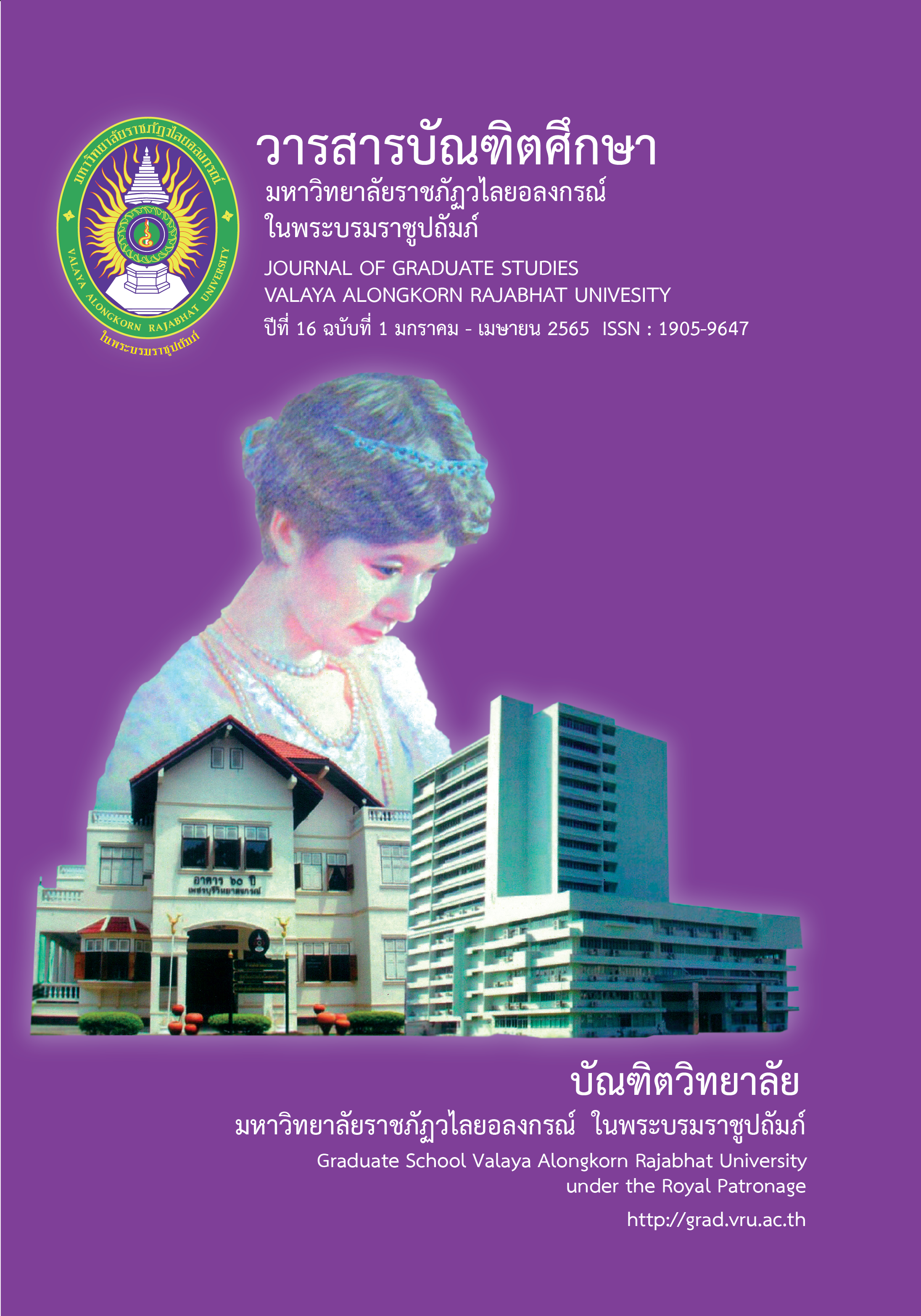THE DEVELOPMENT OF LEARNING MANAGEMENT PROCESS TO ENHANCE ABILITY ON MATHEMATICAL PROBLEM SOLVING AND PROBLEM POSING FOR SECONDARY STUDENT
Main Article Content
Abstract
The purpose of this research were to 1) develop the learning management process to enhance ability on mathematical problem solving and problem posing for secondary students, 2) evaluate the learning management process. There are three phases of research method. Phase one is to study documents and research related to learning theory. Phase two is to draft the learning management process. Phase three is to evaluate the appropriateness of learning management process. The subject of this study was five informants who were experts in curriculum & instruction and teaching mathematics. The instrument in this study was the evaluation form for assessing the learning management process.
The research found that 1) the learning management process comprised 3 concepts which were (1) Cognitively Guided Instruction (2) Problem Based Learning (3) Brainstorming. 2) The result showed that the learning management process to enhance ability on mathematical problem solving and problem posing was appropriate at a high level.
Article Details

This work is licensed under a Creative Commons Attribution-NonCommercial-NoDerivatives 4.0 International License.
บทความทุกเรื่องได้รับการตรวจความถูกต้องทางวิชาการโดยผู้ทรงคุณวุฒิ ทรรศนะและข้อคิดเห็นในบทความวารสารบัณฑิตศึกษา มหาวิทยาลัยราชภัฏวไลยอลงกรณ์ ในพระบรมราชูปถัมภ์ มิใช่เป็นทรรศนะและความคิดของผู้จัดทำจึงมิใช่ความรับผิดชอบของบัณฑิตวิทยาลัย มหาวิทยาลัยราชภัฏวไลยอลงกรณ์ ในพระบรมราชูปถัมภ์ กองบรรณาธิการไม่สงวนสิทธิ์การคัดลอก แต่ให้อ้างอิงแหล่งที่มา
References
Adams, J. (1979). Conceptual blockbusting: A guide to better ideas. 2nd ed. New York: W. W. Norton.
Barell, J. (2010). Problem-Based Learning: The Foundation for 21st Century Skills” In J. Bellanca & R. Brandt. (Ed.), 21st Century Skills Rethinking How Students Learn. (pp. 175-199). Bloomington: Solution tree Press.
Baxter, J. (2005). Some Reflections on Problem Posing: A Conversation with Marion Walter: Reflect and Discuss. Teaching Children Mathematics. 12(3), 122-128.
Butterworth, J. & Thwaites, G. (2010). Thinking Skills. 8th ed. Cambridge: Cambridge University Press.
Carpenter, T., Fennema, E., Franke, M., Levi, L., & Empson, S. (2015). Children’s Mathematics: Cognitively Guided Instruction. 2nd ed. Portsmouth: Heinemann.
Cheausuwantavee, C. (2012). kānphatthanā rūpbǣp kān rīan kānsō̜n khanittasāt phư̄a songsœ̄m khwāmsāmāt nai kān khit khan sūng læ čhitta nisai khō̜ng nakrīan radap chan matthayommasưksā [The Development of Mathematics Instructional Model to Enhance Higher Order Thinking and Habits of Mind of Secondary School Students]. Doctoral dissertation. Silpakorn University.
Delisle, R. (1997). How to Use Problem-Based Learning in the Classroom. Virginia: Association for Supervision and Curriculum Development.
Erickson, D. (1999). A Problem-Based Approach to Mathematics Instruction. The Mathematics Teacher. 92(6), 516-521.
Hersch, R. (1997). What is mathematics really? Oxford: Oxford University Press.
Hoosain, E. & Chance, R. (2004). Problem-Solving Strategies of First Graders. Teaching Children Mathematics. 11(9), 474-479.
Katwibun, D. (2018). kānrīanrū dōi chai panhā pen thān samrap khrū khanittasāt [Problem-Based Learning for Mathematics Teachers]. Chaianmai: Jarus Business Printing.
Lambros, A. (2004). Problem-Based Learning in Middle and High School Classrooms a Teacher’s Guide to Implementation. California: Corwin Press.
National Center for Research in Mathematical Sciences Education. (1992). Cognitively Guided Instruction. The Teaching and Learning of mathematics. 1(2), 5-9.
National Council of Teachers of Mathematics. (2000). Principles and Standards for School Mathematics. Virginia: NCTM.
Osborn, A. (1963). Applied Imagination: Principles and Procedures of Creative Problem-Solving. 3rd ed. New York: Scribner.
Polya, G. (1957). How to Solve It. New Jersey: Princeton University Press.
Rawlinson, J. (1981). Creative Thinking and Brainstorming. England: Gower Publish.
Silver, E. & Cai, J. (2005). Assessing Students’ Mathematical Problem Posing. Teaching Children Mathematics 12(3), 129-134.
The Institute for the Promotion of Teaching Science and Technology. (2012a). thaksa læ krabūankān thāng khanittasāt [Mathematical Skill and Process]. 3rd ed. Bangkok: 3-Q media.
The Institute for the Promotion of Teaching Science and Technology. (2012b). khrū khanittasāt mư̄ʻāchīp sēnthāng sū khwāmsamret [Professional Mathematics Teacher Way to Success]. Bangkok: 3-Q media.
Thipkong, S. (2013). kān kǣ panhā khanittasāt [Mathematics Problem Solving]. 2ed ed. Bangkok: BOWT Printing.
Torp, L. & Sage, S. (1998). Problems as Possibilities Problem-Based Learning for K- 12 Education. Virginia: Association for Supervision and Curriculum Development.
University of Pittsburgh. (2010). Teaching Techniques Brainstorming. Retrieved from http://icre.pitt.edu/cbe/documents/Info%20Sheet%20PDFs/Teaching%20TechniquesBrainstorming_Info%20Sheet.pdf
Whitin, P. (2004). Promoting Problem-Posing Explorations. Teaching Children Mathematics. 11(4), 180-186.


